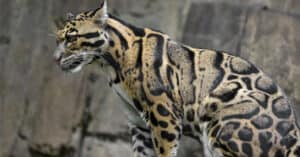Native to the Himalayas, southeast Asia, and China, clouded leopards (Neofelis nebulosa) live mainly in forests and woodlands. Distinguished by their cloud-shaped spots and stripes, clouded leopards are stunning animals but well camouflaged. They are secretive and solitary hunters but have incredibly powerful jaws with enough force to kill with a single bite. However, it’s their teeth that make these big cats so unique, but what exactly is so special about them? Join us as we discover everything you need to know about clouded leopard teeth!
The Milk Teeth of Baby Clouded Leopards
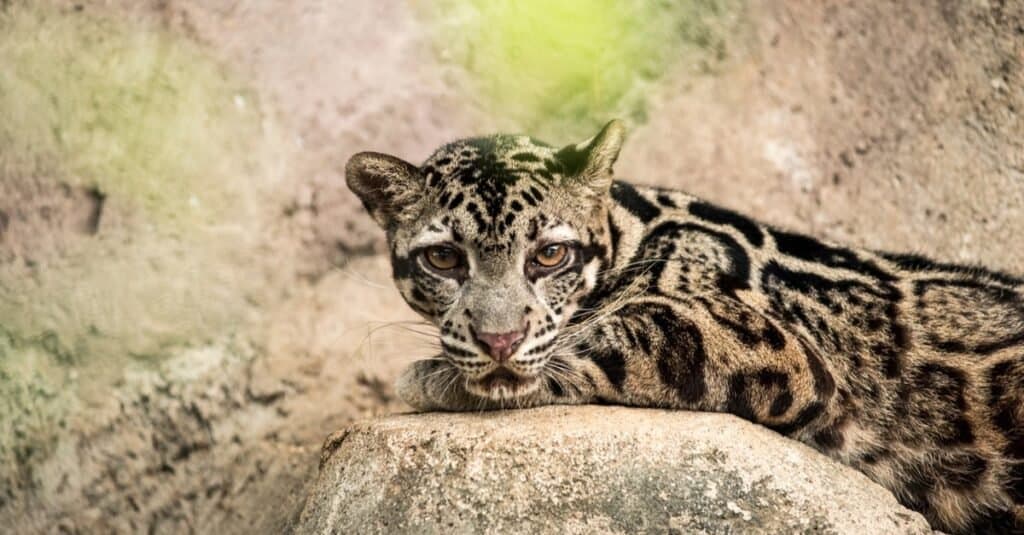
Clouded leopards have been 24 and 26 milk teeth which begin to emerge when they are 3 weeks old.
©studio382.net/Shutterstock.com
Clouded leopard cubs are tiny when they are born – weighing around 6 ounces. Their eyes and ears are closed and they have no teeth. Instead, they rely on their mother to provide milk for them, which they feed exclusively on for the first six weeks of their lives. At around three weeks old their very first teeth begin to emerge – known as milk or deciduous teeth. Clouded leopards have 24 to 26 milk teeth which consist of twelve incisors, four canines and eight to ten premolars.
By the time they’re six weeks old clouded leopards have most of their milk teeth and are able to begin chewing on solid food while still being supplemented by their mother’s milk. Clouded leopard cubs continue to nurse from their mother until around 14 weeks. However, they are not completely weaned and independent until around 9 months old. By this time all of their milk teeth have been replaced by their permanent adult teeth.
How Many Teeth Do Clouded Leopards Have?
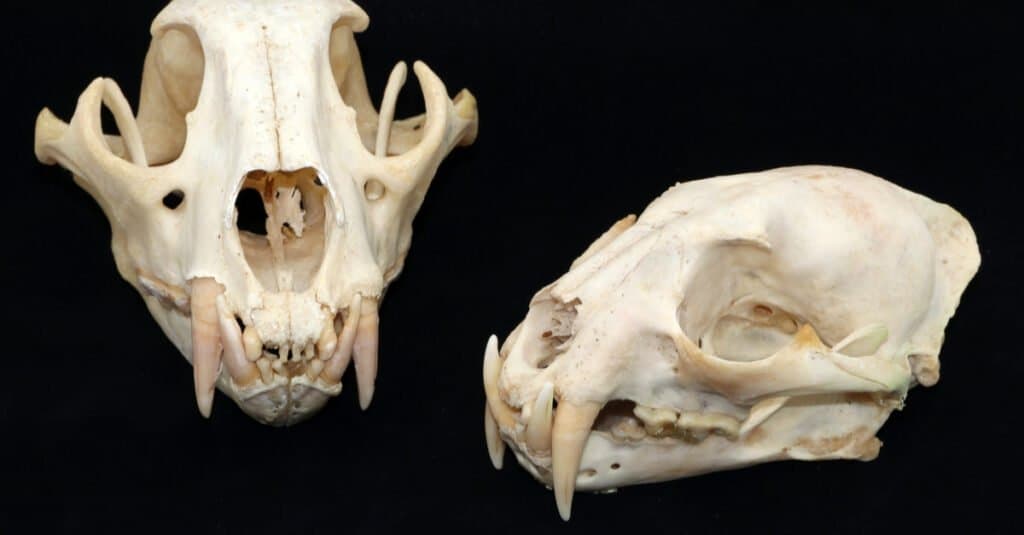
The skull of clouded leopards shares similarities to now extinct saber-toothed cats
©Various images/Shutterstock.com
Clouded leopards are solitary predators but are extremely strong and are capable of taking down prey that are much larger than they are. They are mostly nocturnal and are ambush predators. Clouded leopards hunt either by lying in wait on the ground for their prey or by pouncing from a tree. They are excellent climbers and have even been known to hang upside down from a tree by their hind feet while snatching prey.
However, one of their most unique features of clouded leopards is their large, sharp canine teeth. Clouded leopards are actually known for having the largest canine teeth of any living cat in proportion to their body size. Clouded leopards have 32 adult teeth, which consist of twelve incisors, four canines ten premolars, and six molars.
Incisors
Clouded leopards have a row of six incisors on both their upper and lower jaw. These teeth are relatively small but sharp. However, the outermost incisors on the upper jaw are slightly larger than the middle ones. These teeth are generally used for gripping prey with.
How Big Are Clouded Leopard Teeth: Their Canines
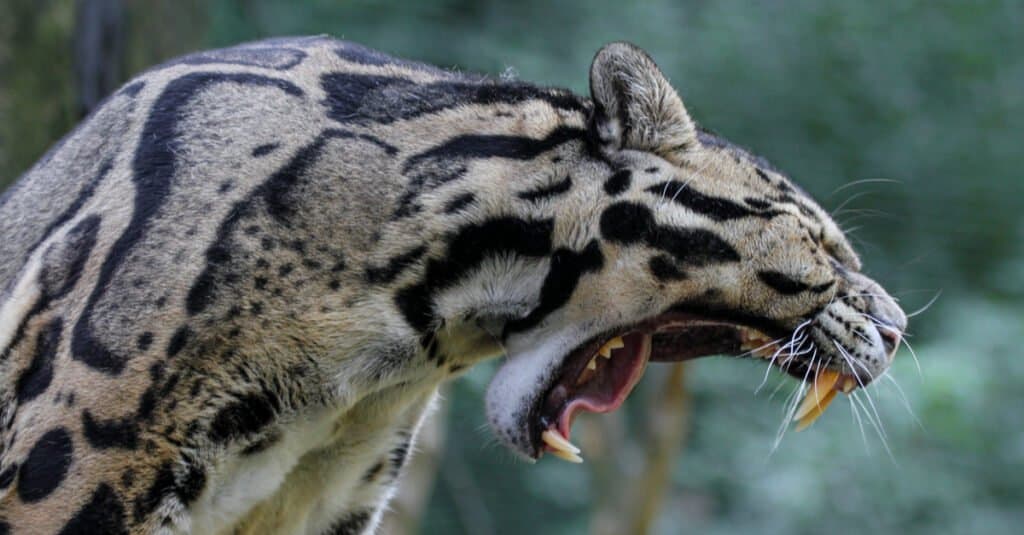
Clouded leopards have canine teeth that are around 2 inches long
©Adalbert Dragon/Shutterstock.com
The most impressive teeth on a clouded leopard are their long canine teeth. These teeth are around two inches long, although sometimes longer. These are the largest in relation to body size than any other cat. As a comparison, a tiger’s incisor teeth are 2.5 to 3 inches long even though tigers are more than ten times bigger than clouded leopards. The canine teeth are long and extremely sharp, but have a conical shape. This is thought to make them stronger for resisting the movements of their struggling prey.
The main purpose of these super long canines is killing prey. Clouded leopards have the ability to kill their prey using one swift bite to the back of the neck with their canine teeth. They have a bite force of 544 Newtons and a bite force quotient of 122.4 (a tigers is 127). Clouded leopards prey on deer, gibbons, macaques, slow loris, and wild boar, as well as birds and rodents. As well as killing their prey with their incisors, clouded leopards use them for tearing chunks of meat off.
Premolars
Clouded leopards have ten premolars, of which they have three upper and two lower teeth on each side of their jaw. Premolars are chewing teeth and are used for chewing bone, skin and muscle.
Molars
The molars are situated the farthest back on the jaw and clouded leopards have one upper and two lower teeth on each side of their jaw. Along with the premolars, these teeth are known as “carnassials”. Carnassials are teeth that have sharp crowns and are positioned in such a way that they work in a scissor-like fashion. This means that they are perfect for slicing through tough muscles and sinews when the clouded leopard is eating.
Clouded Leopard Teeth vs. A Saber-Tooth
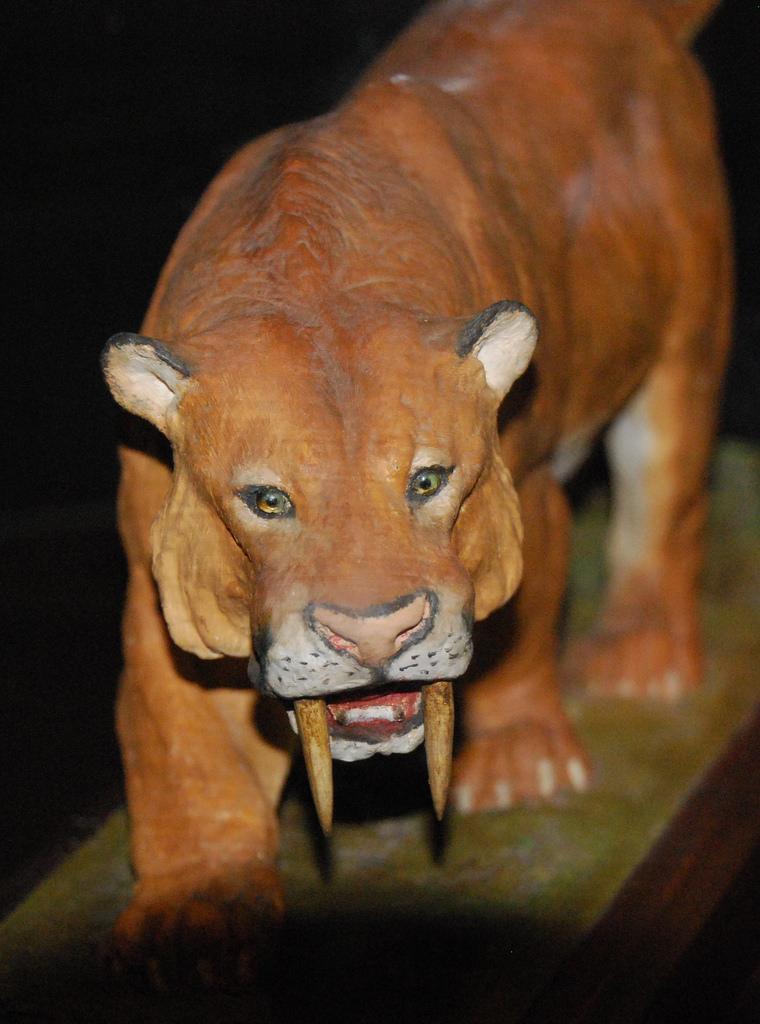
A model of a sabre-tooth cat showing the long, protruding canines
As we’ve already mentioned, clouded leopards have the longest canines teeth in proportion to their body of any other living animal. This surprising feat has led to them earning the name “modern-day saber-tooth”. In fact, there have been many comparisons between clouded leopards and the now-extinct sabre-tooth cats. Saber-tooth cats were named because of their extraordinarily long canine teeth. Their canines protruded from their mouth even when their mouth was closed and were up to 8 inches long. Saber-tooth cats are an extinct subfamily of the Felidae family group (clouded leopards are the subfamily Pantherinae) and the best known saber-tooth is the Smilodon.
Research has shown that the skull of clouded leopards has a lot of similarities with that of saber-tooth cats in the Paramachairodus genus (which includes the Smilodon). Clouded leopards are also able to open their mouth at an angle of 100 degrees – just like saber-tooths. Not only that, but saber-tooth cats and clouded leopards share the shame method of killing their prey. Unlike most other big cats that kill their prey by biting the throat of their prey, clouded leopards kill by biting the back of the neck. This usually severs the spinal cord in one swift action. Saber-tooths are believed to have killed their prey in exactly the same way and were known as some of the best hunters of large prey around. This suggests that clouded leopards and saber-tooths might share more than just a name.
The photo featured at the top of this post is © Adalbert Dragon/Shutterstock.com
Thank you for reading! Have some feedback for us? Contact the AZ Animals editorial team.



